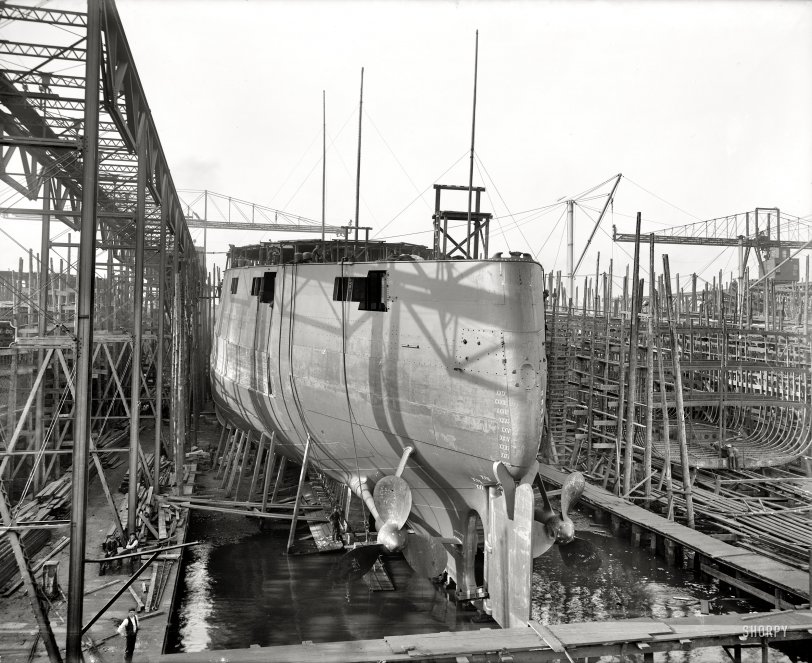


Framed or unframed, desk size to sofa size, printed by us in Arizona and Alabama since 2007. Explore now.
Shorpy is funded by you. Patreon contributors get an ad-free experience.
Learn more.

- Baldwin 62303
- Baldwin VO-1000
- Cold
- No expense spared
- Tough Guys
- Lost in Toyland
- And without gloves
- If I were a blindfolded time traveler
- Smoke Consumer Also Cooks
- Oh that stove!
- Possibly still there?
- What?!?
- $100 Reward
- Freeze Frame
- Texas Flyer wanted
- Just a Year Too Soon
- WWII -- Replacing men with women at the railroad crossing.
- Yes, Icing
- You kids drive me nuts!
- NOT An Easy Job
- I wonder
- Just add window boxes
- Icing Platform?
- Indiana Harbor Belt abides
- Freezing haze
- Corrections (for those who care)
- C&NW at Nelson
- Fallen Flags
- A dangerous job made worse
- Water Stop
Print Emporium
Battleship: 1905

October 22, 1900. "Russian warship Retvizan, day before launching, Cramp's shipyards, Philadelphia." This battleship had its ups and downs -- built for the Imperial Russian Navy, torpedoed during the Russo-Japanese War, refloated, then sunk, then raised, then commissioned in the Japanese Navy, then sunk again. Whew. 8x10 inch glass negative, Detroit Publishing Co. View full size.
Cramp's style (sorry)
From Philaplace (with 27 very nice images from late 1800s-1943)):
The Cramp shipyard, founded in 1830 by William Cramp, actively participated in the modernization of the shipbuilding industry, from a craft mode of production focused around wooden sailing vessels to an industry centered around steam engines and iron and steel construction. At its height during World War II, it employed roughly 18,000.
Rather Inefficient
With all the time that boat spent underwater, they should have just built it as a submarine.
Day before launching?
How on earth would this ship be ready to launch the next day? There looks to be a whole lot of work remaining. There isn't even a superstructure yet, nor has the hull been finished being armored.
They have a long day ahead of them!
[A lot of that gets done after launching. - Dave]
Armor
The wood backing also acted the same way as a "splinter deck" absorbing the razor sharp steel splinters that would be propelled outward from the point of impact literally shredding anyone or thing in its path.
XXV
Those pesky 'Roman Numerals' again. Still can't understand why we stopped using them all the time; they're so clear and easy to understand.
Teak Backing
This photo gives an extremely rare view of the wood backing through which heavy armor plate was attached on most armored ships before World War II. (The latest armored ships used concrete as the backing material).
It was established in the Civil War period that a wooden backing helped to distribute the shock of a hit on the armor, and teak was selected by most navies as the best material. As armor technology evolved, the surface was case hardened by a number of different processes depending on what facility did the work. This surface was so hard and brittle it could accept no fasteners, and therefore, holes had to be cut part-way into the armor from the back and threaded rods inserted into them. The armor plates were hoisted into place with a crane, very carefully sliding the rods into corresponding holes in the backing and the ship's structural plating behind them.
You can see the wooden planks -- that's the backing -- in way of the armor belt at the loaded waterline that hasn't yet been applied, and the holes already made to accept the rods. Once the armor was in place, washers and nuts had to be screwed onto the ends of the rods that would be showing inside the hull plating to hold the armor in place.
Wikipedia says the armor belt was 9 inches thick and was US-made, but according to Krupp's process.
























On Shorpy:
Today’s Top 5